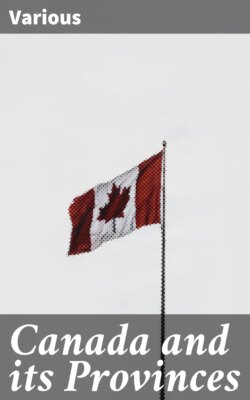Читать книгу Canada and its Provinces - Various - Страница 14
На сайте Литреса книга снята с продажи.
I
FIRST VOYAGES WESTWARD
ОглавлениеTable of Contents
Cartier’s voyages to the St Lawrence had become, in the beginning of the seventeenth century, little more than a memory, so that when Samuel Champlain began his explorations in North America he was entering what were practically new fields. When Champlain made his appearance on the St Lawrence in 1603 as a member of Pont-Gravé’s expedition, the Huron-Iroquois race, which inhabited the region in Cartier’s time, had disappeared from the river, and with it the villages of Stadacona and Hochelaga. Basque and Breton fishermen had visited the mouth of the St Lawrence, and Tadoussac was the chief place of trade. Here, on May 28, a thousand natives, Algonquins, Etchemins and Montagnais, all belonging to the great linguistic family now designated Algonquin, greeted Pont-Gravé’s party with friendly demonstrations. Among them were Indians from Allumette Island on the Ottawa, under their one-eyed chief Tessoüat. Some months later, around the camp-fire, smoking the calumet, the French and savages entered into a formal alliance against the latter’s inveterate foes, the Iroquois, now so named for the first time in history. This alliance had momentous effects upon the course of discovery and exploration in Canada.
Cartier’s Hochelagans could only speak from hearsay of the upper reaches of the St Lawrence, but Champlain’s Algonquins had penetrated to remote regions north and west, and their information was at first hand. They told of Lakes Ontario, Erie and Huron, of canoe routes by the rivers Trent, Oswego and Genesee, of a high cataract at the west end of the lower great lake, and of the portage round it; but Champlain gathered from the savages that little water came over the falls. Clearly then the upper lakes must have another outlet to the west into a northern or southern sea. In his eagerness to believe that he was on a direct water route to Cathay, he understood the savages to say that the waters of the uppermost lake became salty towards the west, but that it was so vast and stormy that no one had reached its western limits. Champlain came to the conclusion that by the river and lake route he would find the outlet to the Western Sea, the goal of all western explorers. Seven years were to pass before he was to have an opportunity to follow up the information he had received from the Algonquins.
In 1608 Champlain founded Quebec. During the first winter the colony was almost destroyed by disease. Of the original twenty-eight settlers but eight survived. The arrival of Pont-Gravé in June 1609, with men and provisions, gave Champlain new courage. Shortly afterwards he set out in a sloop to invade the country of the Iroquois. Joining forces with the Hurons and Algonquins, he led his motley host up the Richelieu River to the lake since called by his name. Near Ticonderoga a war-party of Iroquois was encountered. A short, sharp fight took place on the shore of the lake. Champlain and two French followers, armed with arquebuses, carried death and terror into the ranks of the foe, who were filled with superstitious dread at the noise and execution of weapons hitherto unknown to them. It was an easy victory, but in the end dearly purchased. In this same year the Half-Moon, carrying Henry Hudson and his Dutch sailors, ascended the river which now bears his name to the country of the Mohawks. Following up Hudson’s discovery, Dutch traders settled at Fort Orange (now Albany) and entered into friendly relations with the natives. The Iroquois, exchanging peltry for guns and ammunition, were soon in a position to contend on more equal terms with the French. For nearly a century and a half they exacted fearful retribution for Champlain’s offence. Soldier and missionary, settler and trader, adult and infant, alike fell before the murderous Mohawks, and French scalps adorned many an Iroquois cabin.
